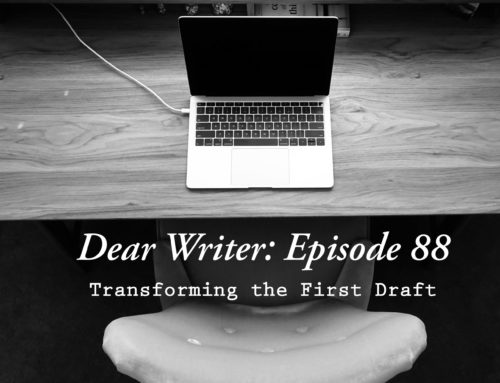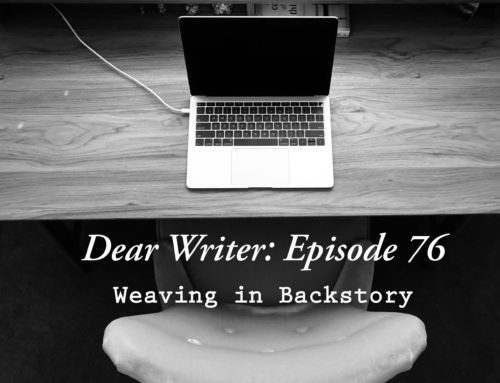The Art of Emotion
This craft episode was devoted to the art of creating emotion in your characters and in drawing out emotion from your readers. We discussed tips and tricks we use to engage readers by creating realistic emotion-driven scenes, and why the reader’s emotional connection to the characters is important.

Episode Summary:
Main Discussion: Art of emotion
I think there are two main branches to this conversation. 1. The art of showing the emotion of your characters in your stories, 2. The art of bringing out emotions in your readers.
We will start by talking about ways to reveal the emotions of your characters. Firstly, what are some techniques for identifying the emotions your characters are feeling?
Sarah: As cheesy as it sounds, you have to put yourself into your characters shoes. Firstly I consider backstory… if this, this and this had happened to me, how might I react? But then, you can’t solely base it off that either, because your character may have different personality traits. So, I examine the situation and think about the possible ways people might react in that situation. Then identify out of those possible ways which one your character is most likely to identify with given their history and their personality. I remember we had an interesting contrast occur when drafting Darkness, Set Us Free. Something happened to two of our characters, and they reacted in really different ways. One of them who had been, let’s just say ‘traumatised’ by a similar situation was a complete mess, and very emotional about the situation. But she was also a very emotional character to begin with due to her history. The other character I initially thought would be quite angry—anyone would be in that situation. And he was, sort of. But whenever I tried writing him like that it didn’t fit. He was actually pretty understanding of the situation and a lot more level-headed.
Ashley: First think about who your character is, especially taking into account their backstory and the personality traits. This usually gives you a starting point to how your character will react in a specific situation. This leads me to my main piece of advice which is to play/write out different emotional responses of your character to the situation. I do this often. Sometimes, the first pass doesn’t feel right, and that’s OK. Remember, just because you might be angry in that particular situation, your character might not be.
Some writers suggest keeping a journal to help identify and draw inspiration for the emotions of your characters. Have we tried this?
Sarah: I have journaled but I’ve said at one point that I stopped writing the emotional stuff cause I hate to read it, haha! Honestly, I have a really great memory for remembering emotions and the way certain things made me feel. So if I need to feel an emotion, I run through my memories and find something that brought out a similar emotion within myself. Then the task is to try to portray that accurately onto the page. I think for me journaling wouldn’t be very helpful as even though I may write something in a particular state of mind, the writing itself may not accurately portray the emotion of how I’m feeling, if that makes sense. Or to be more accurate, rereading the stuff you wrote previously might bring up different emotions as you revisit it. For example, if I wrote something in a state of anger, later I might think it sounds petty. And that feeling of exasperation and annoyance with myself that arises when I read back over something I now view as petty and unimportant gets in the way of the emotion that I actually want to bring to the surface. So, it really depends who you are as to how much journaling might help you.
Ashley: I’ve said before on the show that I have never really journaled. Though, I can see the value of having some trains of thought written down from intensely emotional situations that could aid you in accurately writing a similar emotional response from your character.
What are some writing techniques for revealing emotion in your characters?
Sarah: I said in the last question that I like to think of a memory that brings up a similar emotion. But it’s more than that because you have to translate it onto the page. So, some techniques I use to try to use is, once I have that memory and I can visualize myself acting out that memory, I try to see the little things I did that shows the emotion. Say I’m in the middle of a confrontation with someone. I was nervous, fearful. OK. I can see myself tucking my hair behind my ears. My voice became snappier, shorter. Defensive. I crossed my arms. I stared at the person directly in the eye. When the confrontation was over I felt a bit shaky. Relieved. This kind of breakdown of a memory when you view yourself from a third person’s perspective I find really helpful. And then, if I’m struggling with a new and interesting way to describe something, I do have The Emotion Thesaurus by Becca Puglisi and Angela Ackerman, which is pure gold! We’ve reviewed this on one of our talking shop episodes.
Ashley: The two most common techniques for me are probably using body language to try and show what emotions the characters are feelings, and internal dialogue. I usually like to combine both these techniques with dialogue.
Readers often seek out fiction to be transported to another world. One of intense emotion. These emotions can be positive – happiness or falling in love. They also be deep, visceral emotions like grief, fear, or anger. Authors strive to bring out emotional reactions in their readers. We want to make them laugh, cry, or have a response to a particular character. Why is it important to try and get an emotion response from your readers?
Sarah: If your readers aren’t experiencing emotion as they read your book (with the exception of non-fiction), the readers aren’t engaged, and don’t care about what’s happening. Most readers, if it doesn’t stimulate them to an emotional response of some kind will ultimately stop reading. They want to experience the highs and lows, because reading is one of the ways we can experience such a broad range of emotions safely, and a good book can do this and take them out of their own experience.
Ashley: You want your readers to keep on reading and want to read more of your work. If you can make them build a strong emotional connection/response to your characters, you’ve gone a long way to keeping them coming back for more.
Firstly, what is the importance of readers identifying with the protagonist to bring up an emotional response.
Sarah: When people read your book, they need someone to help them navigate through. Without navigation which is usually offered by the viewpoint of the protagonist, the world in your book would be confusing and that confusion creates distance between the reader and the characters. So, by choosing a protagonist the reader identifies with, it gives them an anchor. But that anchor is only as strong as the strength of the relationship between your protagonist and the reader. So, you need the protagonist to be easily identifiable to a lot of people, and usually have at least one redeeming feature that resonates with your readers in order to bring the readers closer to the character. As the reader follows the protagonist, and the protagonist goes through a series of hurdles both physically and emotionally, if the character is showing real emotion and undergoing change, the bond between the reader and the protagonist deepens. Even though the reader may at times have different levels of knowledge than your character (they may know more about the overall plot) that knowledge should never weaken the bond between the reader and the protagonist. Instead it should bring up other emotions in the reader, for example dread if they see something that’s about to go wrong. Or sympathy if they see the character is hurting but recognise there is a wider lesson the character has to learn.
Ashley: When readers identify with your protagonist, they inherently identify with their emotions. This allows your reader to build a stronger emotional connection with your character so they actually care about what happens to the character in the end — when the character hurts, so does the reader. When character wins, so does the reader.
What are some writing techniques you can use to evoke emotion in your reader?
Sarah: I know Ashley is going to talk about this, but I 100% agree that word choice is really important. You can’t just choose any word out of the thesaurus to describe something… even though words might be similar they never convey the exact same meaning or carry the exact same tone. If I’m struggling and can’t remember a word, I’ll often use a thesaurus not to find an alternate word, but to help me work out what it is I’m trying to get across. So, I’ll be thinking as I’m writing, well this isn’t the word, but it’s close to the word I’m looking for. Then I’ll take that word and look it up in a thesaurus and keep searching similar words until I eventually find the one that I was looking for all along. And another for me is description of the setting. I love the fact that before your character even starts doing anything, you can convey a mood and a general emotion through vivid imagery. Using colours, symbolism, and motifs. Drawing the reader’s attention to specific objects—these can all evoke emotion in the reader.
Ashley: Specific word choice. I think this is really important to articulate what is going on with your reader. This can be for describing how a character is feeling/walking/acting. Even specific word choices in dialogue, does your character usually curse? I spend quite a bit of time trying to find the perfect word in specific situations. Another technique is pacing. Both with respects to action followed by slower moments, and pace created by varying sentence length a structure. I do this quite a bit to hammer home important scenes. Short (even one word) sentences punctuated throughout emotional scenes can pack a punch. Finally, cut out the waffle. You don’t want to bore your reader in emotional moments. Only write what is required for the scene. Cut the rest out.
Some common mistakes to avoid when writing emotions
Sarah: Not having enough emotion—sometimes we get so tied up in trying to ‘show not tell’ that we end up cutting out all internal thoughts and feelings. You don’t want to state it directly, but remember that your reader needs to connect to the character’s emotions. ‘Showing’ is actually a bit of a misnomer, I think because it makes you believe everything has to be visually portrayed. Ironically, you end up doing the opposite and telling the reader what happened: ‘this happened, then that happened, then that happened’. In actual fact, real showing involves using the techniques we’ve talked about to engage the reader and create emotion, not just showing the reader visually what happened. I’ve talked before about an action scene I edited where it felt flat and robotic. Even fast paced action scenes need some emotion inserted into them. I ended up showing how the character was feeling about his actions by using comparisons, like I had the character imagine what he looked like and what the other characters thought of him. I also inserted more detailed and specific description which had the effect of blurring out the surroundings and focussing on this one thing the character felt terrified about.
Ashley: Using cliches too often to describe emotions. Just stating the emotions – sad, angry, happy. Try and focus on describing the signs and thoughts of the emotion rather than just using the word.





















Leave A Comment